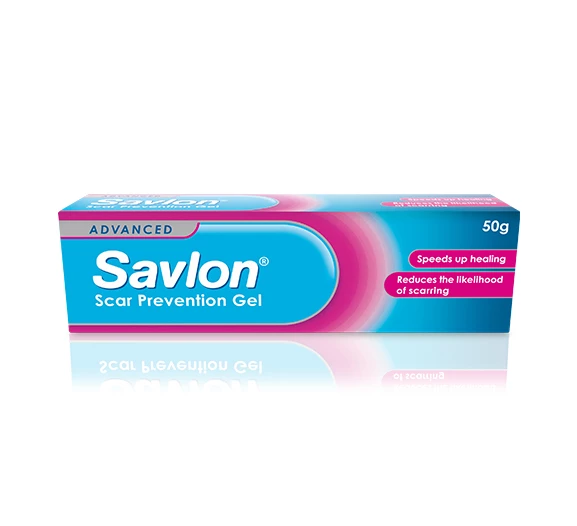Everyday injuries, such as paper cuts and minor burns, can cause significant pain & inconvenience to everyday routines. Keep reading to find out how to easily care for minor wounds at home and get tips on how to speed up the healing process so you can get back to your daily life!
Contents:
Wound care at home
1. How to clean a wound at home
2. How to treat a small cut
3. Burn wound treatment
4. How long does a cut take to heal?
5. How to make a cut heal faster
6. Wound healing process
7. How long does a scab take to heal?
Infected wounds
8. How to tell if a wound is healing or infected
9. How to clean an infected wound
10. Savlon products for cuts and wounds
How to clean a wound at home
It can be tempting to quickly bandage up a wound at home or put a plaster on a cut but there are a few more steps you can take to prevent infection and help the healing process to commence.

Wash your hands using soap and water or hand sanitiser.

Apply gentle pressure if the wound is still bleeding with sterile gauze.

Rinse the wound with clean running water for 5 - 10 minutes to remove dirt.

Gently pat the area dry with a clean towel but nothing fluffy like cotton wool.

Apply a sterile dressing to the wound to prevent infection.
How to treat a small cut
Small cuts can easily occur in day-to-day life, from knife cuts in the kitchen to paper cuts when opening the post. It's important to stop the bleeding and clean the wound thoroughly before carrying on with your day to avoid infection.

Wash your hands using soap and water or hand sanitiser.

Clean the wound with an antiseptic wipe.

Apply an antiseptic cream to the cut such as Savlon Antiseptic Cream.

Cover the wound with a plaster.
Burn wound treatment
Burns are also considered a wound and are some of the most common household injuries with many of us likely to have experienced one at some point. First and second-degree burns can be treated at home safely but third-degree burns will require professional medical treatment.
The following steps should be taken to treat first and second-degree burns at home:
- Stop the burn: Remove the source of the burn and any clothing or jewellery near the skin that’s affected.
- Cool the burn: Put the burn under fresh and cool running water for 20 minutes to remove the heat and stop the pain.
- Clean the area: If any blisters have already started to form it’s important to be gentle when cleaning with mild soap and water.

- Don’t touch it: Although it can be tempted to pop the blister, don’t! A blister may form to protect the burn from infection.
- Protect and moisturise: Apply Savlon Scar Prevention Gel to keep the burn hydrated and soothe the pain. Avoid using products containing fragrance as this can irritate the wound.
- Cover the burn: Cover the burn loosely with either a sterile dressing or cling film to protect the wound and any blisters formed.
To learn more about how to treat burns and scalds at home, head over to our burns treatment blog post!
How long does it take a cut to heal?
- Minor cuts and grazes usually take 3-7 days to heal but this can vary depending on how the wound is first treated. If the wound becomes infected, the healing process may take longer.
- How long it takes a cut to heal also depends on the depth of the wound. Deep cuts may need to be treated by a medical professional and stitches to help the healing process.
- Wounds may heal faster if they are covered with a dressing or plaster, which might help to prevent infection.

How to make a cut heal faster
- Keep the wound clean and free from dirt, which could cause infection and delay the healing process.
- Apply Savlon Scar Prevention Gel to help soothe pain and promote faster healing conditions with its hydro-active colloid gel formula.

- Cover the wound with a plaster or sterile dressing to further prevent any dirt or debris from entering the wound.
- Don’t touch it! It can be tempted to touch and pick at scabs but resisting the urge will allow the wound to heal quicker.
Wound healing process
When your body is wounded it will heal in four main stages, these stages include:
- Stop the bleeding: To start the healing process a wound will start to form small blood clots to prevent blood loss. Clotting also helps to heal the wound by forming a scab.
- Scabbing over: Once the wound has stopped bleeding, the body starts to repair the damage by creating a scab. Fresh blood is brought to the surface of the wound to supply white blood cells and oxygen to create a healing environment. This may cause the wound to look slightly inflamed and red.

- Rebuilding: When the wound has been protected by a scab, the body can start to rebuild the skin. The body will tell cells around the wound to create collagen to repair skin and tissue. The wound will start to look more like a scar.
- Strengthening: Even when the wound is no longer open and looks more like a scar, it is still healing under the new skin. As it heals more, the skin will become stronger.
How long does a scab take to heal?
Scabbing is a natural part of the healing process and is essential for protecting a wound whilst healing. Depending on how deep the wound is will determine the healing time of the scab.
Keeping the scab and surrounding skin moisturised and clean helps create optimal healing conditions and prevent chances of infection. Most scabs will fall away on their own once the skin underneath is healed and this usually takes a few days to a few weeks.

Infected wounds
How to tell if a wound is healing or infected?
If a wound becomes infected this can delay the healing process so it’s important to check wounds for signs of infection and treat promptly. If a wound has become or is becoming infected it may:
- Appear swollen and sore to touch
- Become more painful as time passes
- Ooze yellow pus
- Appear red and feel hot to the touch

If an infected wound is not treated promptly the infection may spread and cause further healing complications. If the infection spreads to the blood it causes sepsis which can be life-threatening and must be treated urgently by a medical professional.
If a wound is healing correctly it will become less and less painful as time moves on and the scab will become smaller each day before it falls off. Symptoms such as itching are normal as the skin heals but resisting the urge to scratch is vital for preventing infection!
How to clean an infected wound
Treating a mildly infected wound at home is usually straightforward and easy to do with a household first aid kit (severely infected wounds will require medical attention). You may need some of the following first aid items to clean an infected wound:
- Rubbing alcohol to clean utensils
- Tweezers
- Sterile cloth for cleaning
- Sterile gauze dressing/ bandage
- Savlon Antiseptic Cream

Clean all equipment with rubbing alcohol.

Wash hand thoroughly with soap and warm water, then rinse and dry.

Clean the wound under fresh running water to remove any dirt. You can use tweezers to remove debris such as glass or gravel.

Dry the wound gently with a clean cloth and apply an antiseptic cream, such as Savlon Antiseptic Cream, to help prevent further infection.

Cover the wound with a sterile gauze or bandage.

It’s important to change the dressing at least once a day, especially if it gets damp or dirty, and wash the wound daily too. If the wound still shows signs of infection or doesn’t seem to be healing after 1-2 days, speak to your doctor.





